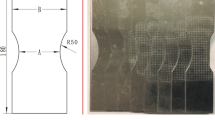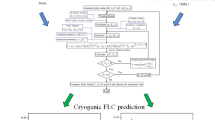Abstract
Considering the recent and widespread use of half-hard rolled aluminum sheets in various industrial sectors, this study aims to characterize, determine and evaluate the formability of these sheets. The first phase is to experimentally determine the forming limit curve of laminated half-hard aluminum sheet AA1050-H24. The FLC is determined experimentally from the limiting strain values measured at the fracture location of the specimen using the Nakazima test. Different geometries of the laminated sheet were produced to obtain different deformation paths in the plane of the main deformations. However, experimentally determining a forming limit curve is very time intensive and requires dedicated and costly equipment. The second phase is to develop an alternative method to replace the experimental protocol. Indeed, we will propose a hybrid approach between the finite element method and necking criterion for determining the onset of localized necking in order to numerically predict this curve. In order to make a numerical prediction, Abaqus/Explicit was used to perform finite element modeling of the Nakazima test. The necking criterion based on the first component of the limit strain was used the time of appearance of necking and to plot the forming limit curve. A comparison of the experimental and numerical results is carried out to determine the effectiveness of the necking criterion in the numerical evaluation of the formability of aluminum sheet AA1050-H24. The necking criterion can numerically evaluate the formability of the AA1050-H24 sheet.















Similar content being viewed by others
Data availability
The authors declare the availability of data and material.
Code availability
Not applicable.
References
El Mrabti I, Touache A, El Hakimi A, Chamat A (2021) Springback optimization of deep drawing process based on FEM-ANN-PSO strategy. Struct Multidiscip Optim 64:321–333. https://doi.org/10.1007/s00158-021-02861-y
D Banabic (2010) Formability of sheet metals, in: Sheet Met. Form. Process., Springer Berlin Heidelberg, Berlin, Heidelberg, 2010: 141–211. https://doi.org/10.1007/978-3-540-88113-1_3
Dehra MS (2006) High velocity formability and factors affecting it [Doctoral dissertation, Ohio State University]. OhioLINK Electronic Theses and Dissertations Center. https://rave.ohiolink.edu/etdc/view?acc_num=osu1143214139
Simoncini M, Forcellese A, Mancini E, Chiappini G, Sasso M (2021) Experimental and numerical investigation on forming limit curves of AA6082 aluminum alloy at high strain rates. Int J Adv Manuf Technol 112:1973–1991. https://doi.org/10.1007/s00170-020-06448-7
Fang J, Zhu Z, Zhang X, Xie L, Huang Z (2021) Tensile deformation and fracture behavior of AA5052 aluminum alloy under different strain rates. J Mater Eng Perform 30:9403–9411. https://doi.org/10.1007/s11665-021-06112-5
Mrabti IE, Bouziane K, Touache A, Hakimi AE, Chamat A, Daya A (2023) Effect of process parameters on the deep drawing formability of aluminum and advanced high-strength steel square cups. Int J Adv Manuf Technol 124:1827–1842. https://doi.org/10.1007/s00170-022-10616-2
Kahhal P, Brooghani SYA, Azodi HD (2013) Multi-objective optimization of sheet metal forming die using FEA coupled with RSM. J Mech Sci Technol 27:3835–3842. https://doi.org/10.1007/s12206-013-0927-8
Wei L, Yuying Y (2008) Multi-objective optimization of sheet metal forming process using Pareto-based genetic algorithm. J Mater Process Technol 208:499–506. https://doi.org/10.1016/j.jmatprotec.2008.01.014
Sun G, Li G, Gong Z, He G, Li Q (2011) Radial basis functional model for multi-objective sheet metal forming optimization. Eng Optim 43:1351–1366. https://doi.org/10.1080/0305215X.2011.557072
SP Keeler Determination of forming limits in automotive stampings, in: 1965:650535. https://doi.org/10.4271/650535
GM Goodwin Application of strain analysis to sheet metal forming problems in the press shop, in: 1968:680093. https://doi.org/10.4271/680093
Banabic D, Lazarescu L, Paraianu L, Ciobanu I, Nicodim I, Comsa DS (2013) Development of a new procedure for the experimental determination of the forming limit curves. CIRP Ann 62:255–258. https://doi.org/10.1016/j.cirp.2013.03.051
Swift HW (1952) Plastic instability under plane stress. J Mech Phys Solids 1:1–18. https://doi.org/10.1016/0022-5096(52)90002-1
Hill R (1952) On discontinuous plastic states, with special reference to localized necking in thin sheets. J Mech Phys Solids 1:19–30. https://doi.org/10.1016/0022-5096(52)90003-3
Marciniak Z (1965) Stability of plastic shells under tension with kinematic boundary conditions (Stability of plastic shell under tension). Archiwum Mechaniki Stosowanej 17(4):577–592 (accessed January 25, 2023)
Keeler SP, Brazier WG (1975) Relationship between laboratory material characterization and press-shop formability. Microalloying 75:517–530
Abspoel M, Scholting ME, Droog JMM (2013) A new method for predicting forming limit curves from mechanical properties. J Mater Process Technol 213:759–769. https://doi.org/10.1016/j.jmatprotec.2012.11.022
Situ Q, Jain MK, Metzger DR (2011) Determination of forming limit diagrams of sheet materials with a hybrid experimental–numerical approach. Int J Mech Sci 53:707–719. https://doi.org/10.1016/j.ijmecsci.2011.06.003
Nakazima, Koe, Kikuma, Toshio, et Hasuka, Kaname (1968) Study on the formability of steel sheets. Yawata Tech Rep --264--, 8517–8530
Nakazima K, Kikuma T (1967) Forming limits under biaxial stretching of sheet metals. Testu-to Hagane 53:455–458
Marciniak Z, Kuczyński K (1967) Limit strains in the processes of stretch-forming sheet metal. Int J Mech Sci 9:609–620. https://doi.org/10.1016/0020-7403(67)90066-5
Hsu E, Carsley JE, Verma R (2008) Development of forming limit diagrams of aluminum and magnesium sheet alloys at elevated temperatures. J Mater Eng Perform 17:288–296. https://doi.org/10.1007/s11665-007-9196-y
Jones SE, Gillis PP (1984) An analysis of biaxial stretching of a flat sheet. Metall Trans A 15:133–138
Banabic D (2010) A review on recent developments of M-K model. Computer Methods in Materials Science 10(4):225–237
Gurson AL (1977) Continuum theory of ductile rupture by void nucleation and growth: Part I—yield criteria and flow rules for porous ductile media. J Eng Mater Technol 99:2–15. https://doi.org/10.1115/1.3443401
Zhang R, Shao Z, Lin J (2018) A review on modelling techniques for formability prediction of sheet metal forming. Int J Lightweight Mater Manuf 1:115–125. https://doi.org/10.1016/j.ijlmm.2018.06.003
A Barfeh, R Hashemi, R Safdarian, D Rahmatabadi, A Aminzadeh S (2022) Sattarpanah Karganroudi, Predicting the forming limit diagram of the fine-grained AA 1050 sheet using GTN damage model with experimental verifications. Proc Inst Mech Eng Part B J Eng Manuf 095440542211389. https://doi.org/10.1177/09544054221138900
Zahedi A, MollaeiDariani B, Mirnia MJ (2019) Experimental determination and numerical prediction of necking and fracture forming limit curves of laminated Al/Cu sheets using a damage plasticity model. Int J Mech Sci 153–154:341–358. https://doi.org/10.1016/j.ijmecsci.2019.02.002
A Heidari, A Ghassemi, A Atrian (2018) Numerical and experimental investigation of forming limit diagrams of 6063 aluminum alloy sheets using Ayada ductile fracture criterion and the second derivative of large strain criterion at increased temperatures. Lat Am J Solids Struct 15. https://doi.org/10.1590/1679-78254974
Hajian M, Assempour A (2015) Experimental and numerical determination of forming limit diagram for 1010 steel sheet: a crystal plasticity approach. Int J Adv Manuf Technol 76:1757–1767. https://doi.org/10.1007/s00170-014-6339-9
Volk W, Hora P (2011) New algorithm for a robust user-independent evaluation of beginning instability for the experimental FLC determination. Int J Mater Form 4:339–346. https://doi.org/10.1007/s12289-010-1012-9
Situ Q, Jain MK, Bruhis M (2006) A suitable criterion for precise determination of incipient necking in sheet materials. Mater Sci Forum 519–521:111–116. https://doi.org/10.4028/www.scientific.net/MSF.519-521.111
Lumelskyj D, Rojek J, Tkocz M (2018) Detection of strain localization in numerical simulation of sheet metal forming. Arch Civ Mech Eng 18:490–499. https://doi.org/10.1016/j.acme.2017.08.004
Yuan W, Wan M, Wu X (2017) Prediction of forming limit curves for 2021 aluminum alloy. Procedia Eng. 207:544–549. https://doi.org/10.1016/j.proeng.2017.10.1018
Lumelskyj D, Rojek J, Tkocz M (2015) Numerical simulations of Nakazima formability tests with prediction of failure. The Romanian Journal of Technical Sciences. Appl Mech 60(3):184–194
Lumelskyy D, Rojek J, Pecherski R, Grosman F, Tkocz M (2012) Numerical simulation of formability tests of pre-deformed steel blanks. Arch Civ Mech Eng 12:133–141. https://doi.org/10.1016/j.acme.2012.04.010
Lumelskyj D, Rojek J, Banabic D, Lazarescu L (2017) Detection of strain localization in Nakazima formability test - experimental research and numerical simulation. Procedia Eng 183:89–94. https://doi.org/10.1016/j.proeng.2017.04.016
1050-H24 Aluminum : MakeItFrom.com, (n.d.). https://www.makeitfrom.com/material-properties/1050-H24-Aluminum
ISO 10113:2020(en), Metallic materials — Sheet and strip — Determination of plastic strain ratio, (n.d.). https://www.iso.org/obp/ui/#iso:std:iso:10113:ed-3:v2
Li Y, Luo M, Gerlach J, Wierzbicki T (2010) Prediction of shear-induced fracture in sheet metal forming. J Mater Process Technol 210:1858–1869. https://doi.org/10.1016/j.jmatprotec.2010.06.021
(1948) A theory of the yielding and plastic flow of anisotropic metals. Proc R Soc Lond Ser Math Phys Sci 193:281–297. https://doi.org/10.1098/rspa.1948.0045
Funding
None.
Author information
Authors and Affiliations
Corresponding author
Ethics declarations
Ethics approval
The article involves no studies on human or animal subjects.
Consent to participate
Informed consent was obtained from all individual participants included in the.
study.
Consent for publication
The publisher has the permission of the authors to publish the given article.
Competing interests
The authors declare no competing interests.
Additional information
Publisher's Note
Springer Nature remains neutral with regard to jurisdictional claims in published maps and institutional affiliations.
Rights and permissions
Springer Nature or its licensor (e.g. a society or other partner) holds exclusive rights to this article under a publishing agreement with the author(s) or other rightsholder(s); author self-archiving of the accepted manuscript version of this article is solely governed by the terms of such publishing agreement and applicable law.
About this article
Cite this article
Bouziane, K., EL Mrabti, I., Touache, A. et al. Numerical prediction and experimental validation of forming limit curves of laminated half-hard aluminum sheets. Int J Adv Manuf Technol 132, 2157–2170 (2024). https://doi.org/10.1007/s00170-024-13473-3
Received:
Accepted:
Published:
Issue Date:
DOI: https://doi.org/10.1007/s00170-024-13473-3




